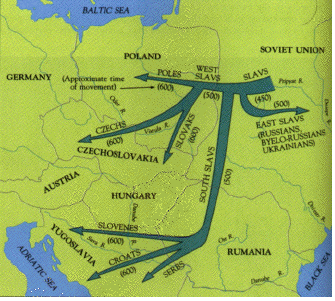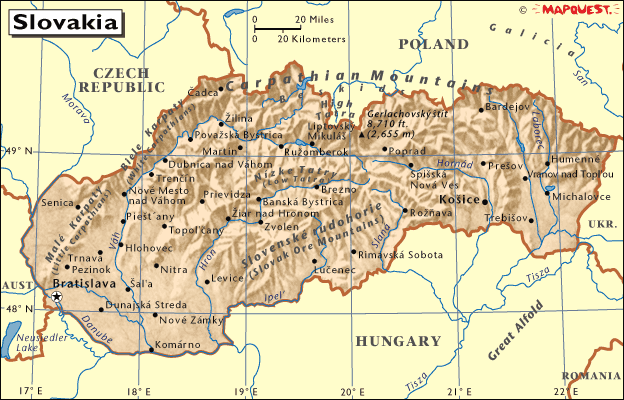This report is based on a “target of opportunity” — an old beat up book from a co-worker; though held together with masking tape and rubber bands, it is something of an heirloom. It was evidently intended as a handy grammar and dictionary and song book for Slovakians emigrating to the USA. Though the title page is missing, a page in the back identifies the author as Edward Kovac, Jr., and the book as published in 1951 by “Obrana Press.” Right in the middle is a 26 page history of the Slovaks, which is just the kind of thing the doctor ordered for us to gradually come up to speed on the history of the forgotten peoples of the world without the need to burrow into 600-page monographs written for specialists.
Slovakia is the “right hand” half of the former Czechoslovakia. Why the two halves ever came together, and why they have split apart, becomes more clear from this short history. I will present the story up to the modern era in this post, and present the 20th century story — which brings to light some very interesting details indeed — in a subsequent one or two.
 For background, examine this map which, though dated, is interesting for showing the migrations of the Slavs. In the period of AD 400-600, one group migrated westward, then split into the Czech, Poles, and Slovaks. A south-bound group divided into the Slovenes, Croats, and Serbs. The third major group doubled back eastward and divided into the Russians, ByeloRussians, and Ukrainians.
For background, examine this map which, though dated, is interesting for showing the migrations of the Slavs. In the period of AD 400-600, one group migrated westward, then split into the Czech, Poles, and Slovaks. A south-bound group divided into the Slovenes, Croats, and Serbs. The third major group doubled back eastward and divided into the Russians, ByeloRussians, and Ukrainians.
In the region of Slovakia, nestled between the Carpathian mountains and the Danube River, the Quadi tribe, which harassed the Romans, was evicted by the Huns 400-455. The Huns were displaced by the Heruli (until 491) who were then evicted by the Lombards. The Lombards crossed the Danube southward, perhaps in response to pressure from the oncoming Slavs. By 527, the Slovaks were in possession, and remain to this day. But soon the Mongol Avar tribe pushed through the area, penetrating into the Frankish kingdom by the end of the century. The Duke of Bavaria pushed back. Finally one Samo — it is not certain whether he was Slovak or Frank — was elected king in 627, and freed the Slovaks from both the Franks and Avars. But upon his death in 662, the tribe gradually fades from view until the rise of Charlemagne in the early 800s, when “Greater Moravia” appears on the stage — a territory which included the later Bohemia (to the west) and Slovakia (to the east) and parts of modern Poland and Croatia.
Moimir I (815-846) expelled rival Pribina of Nitra (see map).  Receiving baptism by the German bishop Urolf, he set up bishoprics in Nitra and Olomouc (100 miles due north of Bratislava), and aided the work of German missionaries. During his rule, there was a Slovak delegation at the Congress of Frankfurt in 822, and the first church was consecrated in Nitra in 833.
Receiving baptism by the German bishop Urolf, he set up bishoprics in Nitra and Olomouc (100 miles due north of Bratislava), and aided the work of German missionaries. During his rule, there was a Slovak delegation at the Congress of Frankfurt in 822, and the first church was consecrated in Nitra in 833.
His successor Rastislav (846-879) made a decision with far-reaching import from our perspective. Himself installed by interference from the German emperor, he nonetheless feared the excessive entanglement of church and empire; especially as such an arrangement interfered with his own plans. Desiring to continue the Christian mission yet be free of the German hegemony, he appealed to the eastern Emperor Michael III in Constantinople. Michael commissioned Cyril and Methodius to continue the missionary work. The diligence of these men left a deep mark. They translated the Bible into the vernacular, in the process inventing the Cyrillic alphabet. This Bible was the first translation into the people’s language anywhere (excepting Greek and Latin). The Germans complained to Rome, but Pope Hadrian blessed the work of Cyril and Methodius and approved the Slavonic liturgy. (Recall that this was before the great east-west division.)
The earlier-banned Pribina and his son Kocel had become hereditary rulers of the Mark Pannonia (region south and west of the Danube at the left end of modern Hungary). They sponsored the education of pious young men in the Slavonic rite.
Meanwhile, nephew Svatopluk I usurped the throne, and sent Rastislav to the mercy of the Germans. The Germans also arrested Methodius on the charge of preaching in their territory; during that ordeal, the priests of Pannonia kept the flame burning. Kovac successfully appealed the treatment of Methodius to Rome. However, none of this happens quickly, and during the confusion, and continuing after Methodius’ death in 885, the Germans were insinuating their influence, with the Latin rite slowly superceding the Slavonic.
The usurper Svatopluk was able to hold his own militarily, and at his death in 894, Great Moravia was at its zenith. But his successor Moimar II faced conflicts in every direction: from his cousin Slavs the Bohemians to the west, the Magyars (Hungarians) to the southeast, and the Germans to the southwest; coupled with distracting rivalries amongst his sons. The Czech Duke Borivoj seceded from Greater Moravia, appealing to the Empire for protection. (As far as I can tell, this was the first time the Bohemians and Slovaks separated as two separate peoples.) In 896 Duke Arnulf of Bavaria joined with the Magyars to wrest Pannonia from Greater Moravia; then double-crossed the Magyars by keeping it — at least so the Hungarians thought. The struggle between Latin/German and Slovak churches continued. In 901 Moimar made peace with the Germans. But in 907 “occurred one of the bloodiest battles in history. In three days the flower of the German army was destroyed, their Moravian allies scattered, and the Magyar hordes victorious. That was the end of Greater Moravia… And what had been a great empire was partitioned among the Magyar, Pole, and Czech” (p. 94). For four centuries, the Slovaks disappeared from the stage of the movers and shakers of history. It was largely the domain of Hungary, and indeed, at times, Slovakia was the only thing left even to the Hungarians. But the people of the land lived on…

I would be very careful with historic texts from that period, and recommend that more recent sources are checked before believing any of the statements.
At that time the Russian authorities had an interest in emphasising the essential unity of the lands they occupied and so giving their occupation historic legitamacy.
That’s not to say the information is wrong, just that it needs to be checked against other sources. All sources have their biases (albeit not as strong as the Communist party propaganda), and hopefully a mixture of bias will get closer to accuracy.
Mr Hodgson — First let me clarify that the paragraph with map about the splitting of the Slav tribes in 400-600 was derived from internet sources, not the book. But that information seems to be consistent with other accounts. The book was published, as far as I can tell, apart from any Russian authorities, let alone in service to some claim of legitimacy Russians might make. It would be just as easy to claim Slovak hegemony over Russia as vice-versa, so far as the splitting of the Slav tribes is concerned. So I find you nervousness in that regard unwarranted.
As to the book, if you have specific information, then please disclose it. But apart from specifics you might provide, I find your advice too harsh. The notion that because a book is published in 1951, one cannot believe that there was such a man as Methodius without cross-checking, seems prima facie absurd to me. Or, if that is so, then the book would be of no value at all — unless there is no book on the subject anywhere of which the same could not be said.
Accuracy is not achieved by mixing biases. Of course, one should check controversial theses — of which I have no clue what you might think to be one in what I posted above — against the arguments of those holding the opposite view. But this method is useful for cross-examination to make sure no stone was unturned, not because the truth is necessarily some kind of golden mean.
12 years later than the post: was anyone of you in Slovakia? The cities still exist and have documents, and very old ruins and mines too.
There is NO WAY that if these people were so ‘scattered’ as Hungarians suggest, they would bloody fight for their autonomy, would 100% keep their language despite being ‘Hungarised’ since they were given to Hungary from kaiser, and no way Hungarians were there earlier than Slavs!
It is only in heads of Hungars who oficially started occupying in 7-8th century, that they possess land because they settled there! No they took it. Same as Ottomans took lands in that time.
Just because they tried to take the land and ignored people who it belonged to originally, should they not be shocked it was finally claimed back. And I tell you, 80% of Slovaks are Slovaks-we don’t speak Hungarian, why would we? Has 0 to do with our language and culture.
If there was no people there, who knew who they were, they would have disappeared over 1000 years of occupying. But Slovaks were there and stayed, though with less land than they had as part of Slavic tribes living south and north Danube, due to arrival of Hungars in 7-8th century. They are unto-fins, and mongol mix, came from east, north east.